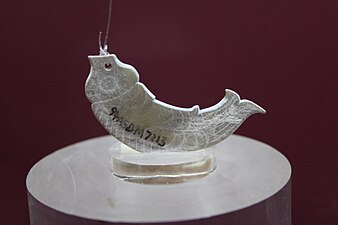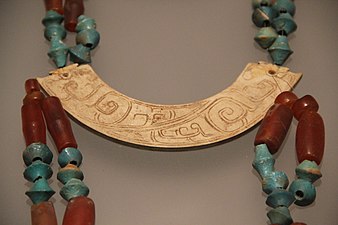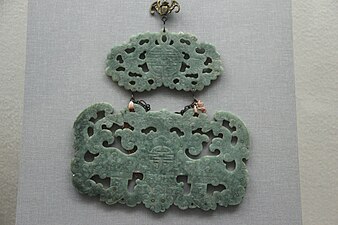Hanfu accessories
Hanfu accessories(Chinese:Hán phục phối sức;pinyin:hànfú pèishì;lit.'hanfu accessories') refers to the various form offashionaccessories and self-adornments used and worn withhanfuthroughout Chinese history.Hanfuconsists of many forms of miscellaneous accessories, such asjewelries,yaopei(lit.'waist ornaments'), ribbons, shawls, scarves, and hand-held accessories, etc.
Jewellery[edit]
Chinese jewellery, including Chinese carvedjadejewellery, often features Chinese symbols and iconography, and auspicious symbols and images, which are themselves rooted in Chinese culture, legends and mythologies, and philosophy.[1][2]: 213 These symbols often reveal the Chinese traditions which have guided the Chinese civilization for thousands of years and which currently continue to remain in use in present-days.[1]

Jade culture is an important aspect ofChinese culture,[3]reflecting both the material and spiritual culture of the Chinese people.[4]: 18 Jade is deeply ingrained in Chinese culture and played a role in every aspect of social life;[4]: 18 it is also associated with positive qualities and aspects such as purity, excellence, and harmony.[5]: 20 [6]: 94 Jade is even more valued thangoldin Chinese culture.[6]: 94 Traditionally, jade jewellery especially often expressed positive sentiments and good wishes; and, jade itself were often gifted on important and/or special occasions such as wedding and child birth.[1]
Silverwas another common materials in the making of Chinese ornaments and ritual items since ancient times; it also holds an irreplaceable place in Chinese culture and plays a significant role in being a carrier of Chinese traditional culture and in preserving ancient Chinese cultural heritage.[2]: 213 Moreover, according to Chinese belief, silver could be used to avoid evil spirits and thus wearing silver ornaments and jewelries was believed to bring good luck to its wearer.[2]: 213
Other materials used in traditional Chinese jewellery making were:gold,shanhu(lit.'coral'),zhenzhu(Chinese:Chân châu;lit.'pearl'),lüsongshi(lit.'turquoise'),chensha(lit.'cinnabar'),niugu(lit.'oxbone').[7]: 250 Niuguwas used as an alternative to a rare material known asxiangya(lit.'ivory').[7]: 250 Zuanshi(lit.'diamond'), on the other hand, was typically not used in traditional Chinese jewellery as it considered too bright and vulgar; and thus, it was generally avoided.[7]: 250
Bracelets[edit]

Jade bracelets have been favoured by Chinese women since ancient times regardless of social ranking[8]and has been one of the most important form of jewellery inChinese culture.[9]According to ancient Chinese beliefs, jade bracelets should be worn on the left hand as it is closest to the heart.[8]Chinese women typically had at least three jade bracelets throughout her lifetime: the first one was given by her father as a little girl, the second is given to the girl by her mother when she gets married and which will be passed from generation to generation as a family heirloom, and the third one (regardless of the price and the quality) is given to the girl by her lover to express his love and his desire to protect her for a lifetime, which led to the saying,"no bracelet can't get married".[8]Another jade bracelet may be given by a mother-in-law to her new daughter-in-law when she gets married.[8]There is a belief in China which says that if a jade bracelet breaks, the death of its wearer has been supplanted by the broken bracelet.[10]: 160 Jade bracelets continue to be prized and worn nowadays. It is also currently used as a form of fashion accessory used by hanfu enthusiasts.[11]
Earrings[edit]

Earrings in China originated in theNeolithic period;however, they were first used as decorations or amulets.[12]A form of popular earring which pierced the earlobe was theer dang(Chinese:Nhĩ đang) which became popular during theWarring States Periodand theQin dynasty.[13]Ancienter dangwere made out gold, jade, silver, ivory, marble, glass and crystal.[13]Glasser dangbecame popular from theHan dynastyto theSouthern and Northern dynastiesdue to its bright colours and due to its glittering characteristics and translucence.[13]
In theZhou dynasty,when in the form of jade pendants, the earrings could also be used as decorations to be hanged onguan,a form of Chinese headgear;[12]they were especially used on themianguanof the Emperor where they became known aschong er(lit.'ear plugs').[14]When used on headgear, thechong erwere a representation of self-discipline and introspection, both of which were important required characteristics in Chinese culture; the purpose of these jade pendants decorations thus reminded its wearer that he should avoid hearing and listening to anything without careful consideration and avoid slander while simultaneously remind the wearer that he should show humility and listen to good suggestions.[12][14]These jade pendants gradually spread from the Emperor to officials and scholars, to women who would then hang it to theirChinese hairpins.[12]Theer dangattached to hairpins were used by empresses, imperial concubines and princesses during the Han dynasty allowing theer dangto hung down beside their two ears.[13]
Based on archaeological findings, it appears that it was a popular trend for ancient women to only wear a singleer dang(especially on the left ear) instead of pairs of earrings.[13]During the Song dynasty that women started to piece their two ears and woreer dang;these earrings could be made with gold and pearls.[12]Wearing earrings among Chinese women then became popular in theMingandQing dynasties.[12]
In the Ming dynasty, the practice of wearing a single earring on the ear was not customary for Chinese men, and such practices were typically associated with the non-Chinese people living along the northern and north-western borders; however, there is an exception: young Chinese boys would wear a single ring-shaped earring attached to their ear as an amulet to protect them against evil spirits.[15]: 208
In Qing dynasty,Han Chinesewomen wore a single earring at each ears which contrasted from the Manchu women who had to wear three earrings at each ear.[16]From the middle of the eighteenth century,Manchuwomen adopted the Han Chinese single earring despite breaking the Manchu dress code and the laws which prevented them from wearing Han Chinese women clothing; this frustrated the Qing emperors.[16][17]
-
A young Chinese boy wearing single ring-shaped earring on the left ear, Ming dynasty
-
Song dynasty empress wearing single gold earring at each ear.
-
Pearl pendant earring, Song dynasty
-
Empress of Ming wearing a dangling earring at each ear.
Rings[edit]
Ringswere initially used as decorations and finger protection when drawing bows since theNeolithic period.[12]They were then given to the Empresses and imperial concubines in the Emperor's concubines to express or indicate their current physical conditions by the Emperor; by the time of Qin and Han dynasties, a gold ring worn on the left hand were used to express being on menstruation or being pregnant and thus that its wearer were unsuitable to serve the Emperor while a silver ring on the left hand expressed that its wearer was available to serve the Emperor; following a night with the Emperor, the silver ring would be moved from left to the right hand.[12]This custom was then gradually spread to the nobles and officials before spreading to the civilians.[12]
Rings which were mostly made of precious materials, such as jade, gold, and silver, were also bestowed presents to accomplished court officials and they were used as love token by couples.[12]Rings later became one of the most important betrothal gift for a bride since theSouthern Song dynasty.[12]
Necklaces[edit]
Yingluo(Chinese:Anh lạc) is currently a common necklace accessory used by hanfu enthusiasts.[11]It is a ring-shaped ornament developed in ancient China, which is hung on the neck and chest, worn on the head, arms and legs. It is mainly made of pearls, precious stones and precious metals. At first, it was used as aBuddhistornament, but later it was widely adopted as anecklaceand headwear in Chinese women's clothing.
There is also a custom of wearing a necklace with alongevity lockpendant,changmingsuo(lit.'longevity lock'). These lock charms were sometimes personally tied around the necks of children by Buddhist or Taoist priests.[18]
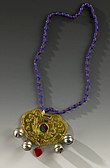
Pendants and charms[edit]
Longevity locks[edit]

The longevity lock is known aschangmingsuo(lit.'longevity lock') has an important form ofamuletfor children for thousand of years in Chinese culture; according to Chinese beliefs, thechangmingsuoprotect children from evil spirits and bad luck by locking its wearer's soul and life inside of the lock.[3]Thechangmingsuois often made with precious materials, such as gold, silver (which is also believed to ward off evil and bring good luck[2]: 213 ), and jade, and having auspicious words carved on it.[3]Thechangmingsuois also a manifestation of the blessing from the older generation who hoped that the child would live a long time (longevity) and remove illness (health).[2]: 213 Both blessings of longevity and health form part of the concept ofwufu(Chinese:Ngũ phúc;lit.'Five fortune'), which are considered to be five important life goals according to traditional Chinese philosophy and beliefs and which hold an important place in every aspect of Chinese culture and life.[19]
Jade pendants[edit]
Yupei(Chinese:Ngọc bội) and had a rigid and specific rules attached to its use.[20]Some jade pendants also combined jades in the shape of dragons, phoenixes, humans, human-dragons, and animals, etc.[20][21][22]In theQingdynasty, it was popular for women to wear green, translucent jade jewelries; pendants which were carved in the shape of a curving dragon was popular.[23]
-
Chinese Jade pendant in the form of abi,2000–1500 B.C.
-
Shang jade pendant in the form of a fish
-
Jade pendants in the form ofstags,Western Zhou.
-
Jade pendant withHuang,Western Zhou
-
Western Zhou JadeHuangfrom a jade pendant.
-
Ming Jade pendant
-
Jade pendant, Qing dynasty
Jinbu[edit]
Ensemble ofjade pendantsand/or jade strings which were combined with other precious materials (such as silver or gold accessories) were calledjinbu(Chinese:Cấm bộ); thejinbuwere a type ofyaopei(waist accessories) which were typically worn by women to press down the hemline of their clothing.[3]Thejinbuappeared thousands of years ago and were initially only worn by nobles, but with time, it was gradually adopted by all women regardless of their social ranks.[3]Thejinbualso used to be an indicator of elegance and etiquette in ancient times: if the behaviour of its wearer is discourteous (i.e. walking too fast), thejinbuwould sound loud; and thus, it would remind the wearer to mind his manners and elegance; on the other hand, if its wearer behave appropriately, thejinbuwould sound melodic and pleasant.[3]This is also explained in the chapterYuzao《Ngọc tảo》in theLiji:[24]
When (the king or ruler) was walking quickly (to the court of audience), he did so to the music of the Cai Qi; when walking more quickly (back to the reception-hall), they played the Si Xia. When turning round, he made a complete circle; when turning in another direction, he did so at a right angle. When advancing, he inclined forward a little; he held himself up straight; and in all these movements, the pieces of jade emitted their tinklings. So also the man of rank, when in his carriage, heard the harmonious sounds of its bells; and, when walking, those of his pendant jade-stones; and in this way evil and depraved thoughts found no entrance into his mind.
— Translated by James Legge, Liji 《 ngọc tảo - Yu Zao》, 37
It is currently used as a form of fashion accessory used byhanfuenthusiasts.[11]
Press lapels[edit]

Yajin(Chinese:Áp khâm;pinyin:yājīn) are used as press lapels on upper garment ornaments; it could include pendants,hebao,and fragrant sachet, andshibazi.
InQing dynasty,Han Chinesewomen wore pendant-like charms asyajin;these pendant-like charms were made of diverse materials (such as jade, amber, gold) and were placed at the top button on the side of theirao-jacket.[25]They also wore other forms of pendants, such as pendants made of metal filigree in the shape ofpotpourricontainer which would be filled with fragrant herbs and long silver pendants with small silver charms which were filled with bells which would frightened evil spirits away when they tickled as they wore.[25]They would also hanghebao(purses) on the top button of their jacket.[25]
A style ofyajinwas theshibazi-style. Ashibaziis a type of 18-beadsbraceletwhich originated from thejapamala.[26]Theshibazisometimes have hanging buckles; they would be hung on the right lapels of upper clothing or could be worn around the wrist like a regular bracelet.[27]There were no strict regulations on its wearing etiquette.[27]
Belts, girdles, and sashes[edit]

Beltsand silk bands are commonly referred asdai(simplified Chinese:Đái;traditional Chinese:Đái).[28]Daihave been deeply connected to ancient Chinese clothing and just like the style of the ancient clothing have known changes over time, so did thedai.[28]Belts were used as accessories for various civil and military officials, and they were used to distinguish their social ranks.[29]
| Name | Description | Period | Images | |
|---|---|---|---|---|
| Taodai | Silk belts or silk narrow bands, made of seven silk bands. Could be woven into 2 different ways.[28] | Ancient - Unknown | ||
| Ke ( khách ) | A narrow band; which could also be of one colour (su); sometimes used as a belt with jadedaigou( đái câu; belt hooks).[28] | Ancient - Unknown | ||
| Sitao ( ti sáo ) | Narrow silk bands, used as belts.[28] | Ancient - Unknown | 
|

|
| Dadai ( đại đái ) or Shendai ( thân đái ) | Silksash;it was worn on top of theshenyi.The belt could have a decorative piece attached on it.[30] | Ancient - Unknown | 
|

|
| Kua ( quả ) | Originated from belts worn in the Zhou dynasty; it was lined with plaques at variable distances, it also had rings or ornaments suspended from its lower edge in order to allow the wearer to attach objects (e.g. knives, tallies, etc.).[29] | Han - Unknown | ||
| Diexie ( điệp tiệp ) | Originated from belts worn in the Zhou dynasty; it was similar to the kua ( quả ) belt, except that it had strips of leather instead of rings. Some accessories like leather pouches could be attached to those belts.[29] | |||
| Guodu
( khỏa đỗ ) or Weidu ( vi đổ ) |
A separate piece of cloth, which has adornment, and was used to wrap the stomach of Han Chinese men.[31] | Song dynasty - Unknown | ||
| Kandai
( khán đái ) |
An adornment belt. It is another belt which is worn on top of the belt worn around the waist for decorative purpose.[31] | Song dynasty - Unknown | ||
| Name | Definition | Description | Period | Images | |
|---|---|---|---|---|---|
| Daigou ( đái câu ) | Belt hook | One end has an elongated body with a knob that goes through the belt; the other end is a curled head that hooks on a loop, ring, or hole on the opposite end of the belt to keep it secure. Made of precious metals and jade; they were less ornamented in the Jin dynasty compared to the ones worn in the Han dynasty.[29]Belt hooks could also be inlaid with yellow and white gold depicting motifs of animals.[28] | Zhou-Jin | 
| |
| Daikou ( đái khấu ) | Belt buckles | Belt buckles with movable tongue. It was introduced during Jin dynasty from the North; originally it was used to secure horse gear instead of clothing.[29] | Jin- Unknown | ||
Neck and shoulder accessories, and ribbons[edit]
| Name | Definition | Period | Images | ||
|---|---|---|---|---|---|
| Pizi | Acape;a wide and short cape which drapes over the shoulders.[30] | Northern dynasties - Tang dynasty. | 
|

|
|
| Pibo
( phi bạch ) or peizi ( bí tử ) |
Ashawl,[32]or a long scarf;[33]it is longer and narrower than the pizi (cape) and it drapes on the shoulder from back to front.[30] | Tang - Unknown | 
|

|

|
| Xiapei( hà bí ) | A woman's neckband which was trimmed with gold and lace.[34]In terms of design, it looked closer to a long scarf; it was worn in formal dress.[35]According to Ming's regulation, the Xiapei length had to be 5.7 chi and 0.32 chi width, with a suspended gold ornament at the end which purpose was to provide weight.[35] | Ming dynasty | 
|
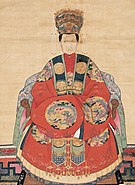
|

|
| A type of stole or tabard worn by women; it was developed from the xia pei worn in Ming dynasty. It was tied at the sides and reached below the knees. The bottom of the xia pei has a pointed hem. It was first worn by women on their wedding day, and later, they would wear on special occasions.[34][36]It is also decorated with colourful tassels at the bottom of the end.[35] | Qing dynasty | 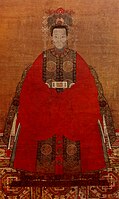
|

|
||
| Lào zi | Knotted ribbon decorations tied to the waist belt made of silk and cotton ribbon.[37] | Ancient – Present | 
|

|

|
| Xian ( tiêm ) | Long ribbons which hung from the upper short skirt.[34] | Wei, Jin and Southern dynasties | 
|

|

|
| Yunjian( vân kiên ) | "Cloud shoulder" or "cloud collar";[38][39]its name is derived from its shape when it is laid flat as it looks like a cloud.[35]It is a detachable collar worn on top of the jacket (and the xia pei in Qing dynasty).[38]It fell around the collar onto the chest and shoulders.[39] | Sui[40]-Qing | 
|

|

|
| Fangxing quling ( phương tâm khúc lĩnh ) | Lit. “bent collar with a square center”.[41]It is pendant-like accessory which falls on the overlapping front of apaofu.[41]It was a notable feature of ceremonial court attire during Song and Ming dynasties.[41]It is made of silk.[41]It consists of a circle at the neck area and an open or solid square which hungs from the circle onto the chest area.[41]The fangxin quling contains the symbolism of Heaven (circle) and earth (square), respectively.[41] | Song - Ming[41] | 
|

|
|

|
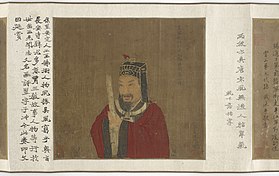
| ||||
Portable accessories[edit]
Purses and fragrance sachet[edit]
Hebao,Chinese purses or sachet, are currently used as a form of fashion accessory used by hanfu enthusiasts.[11]They are often embroidered and can be decorated with tassels.[11]
Yudai[edit]

Yudai(Chinese:Ngư đại;lit.'fish pouch'), also known as "fish-shaped tally bag", is a fish-shapeddai(Chinese:Đại;lit.'pouch or bag'). It is a form ofyufu(Chinese:Ngư phù;lit.'fish tally'); the colour of the pouch corresponds to the colour of the officials' clothing thus indicating its wearer's rank or the special favour of the Emperor; it could be made of gold, silver, or jade. It was worn or hung on the belt of the court clothing[42][43]It was used from the Tang to the Ming dynasty.
Hand-held Fans[edit]
Historically, fans have played an important aspect in the life of the Chinese people.[44]The Chinese have usedhand-held fansas a way to relief themselves during hot days since the ancient times; the fans are also an embodiment of the wisdom of Chinese culture and art.[45]They were also used for ceremonial purposes and as asartorialaccessory.[44]So far, the earliest fans that had been found date to theSpring and AutumnandWarring States Period;these were made of either bamboo or feathers.[46]The arts of fan making eventually progressed to the point that by theJin dynasty,fans could come in different shapes and could be made in different materials.[46]
Tuanshan(Chinese:Đoàn phiến), silk round-shaped fans, also known as "fans of reunion", is a type of "rigid fan".[44][46]These types of fans were mostly used by women in theTang dynastyand was later introduced intoJapan.[47]These round fans remained mainstream even after the growing popularity of the folding fans.[48]Round fans withChinese paintingsand withcalligraphybecame very popular in theSong dynasty.[48]
In 988 AD,zheshan(Chinese:Chiết phiến;lit.'folding fan') was first introduced inChinaby a Japanese monk fromJapanas a tribute during theNorthern Song dynasty;these folding fans became very fashionable in China by theSouthern Song dynasty.[48]The folding fans later became very fashionable in theMing dynasty.[44]
Another popular type of fan in history was the palmetto fan known aspukui shan(Chinese:Bồ quỳ phiến), also known aspushan(Chinese:Bồ phiến), which was made of the leaves and stalks ofpukui(i.e.Livistona chinensis).[47]

Nowadays, both thezheshanand thetuanshanare both often used as accessory in hanfu by Hanfu enthusiasts.[11]
Oil-paper umbrella[edit]
Oil-paper umbrellais a common fashion accessory among Hanfu enthusiasts,[11]who often used for photo-shooting purposes.[49]
Musical instruments[edit]

Nowadays, Chinese musical instruments, such asdiziandguqin,are both common fashion accessory among Hanfu enthusiasts.[11]
Weapons[edit]
In 583 AD during theSui dynasty,civilian ownership of swords and spears were banned by Emperor Wen of Sui; the ban of daggers, knives, hunting forks and hooks followed by the year 604.[50]: xviii This ban was soon lifted following the founding of theTang dynasty,and according to theTang legal code,people were allowed to carry light weapons, bows and arrows, swords, shields, and short spears and were only banned from using professional military weapons.[50]: xviii This led to a cultural shift in the Tang dynasty where gallantry culture rose in popularity.[50]: xix [51]This cultural shift also changed the symbol of swords in society, which became symbols of strength, courage, masculinity, righteousness.[50]: xix [51]It thus became fashionable to carry swords as well as short weapons, such asknivesanddaggers.[51][50]: xix Sending swords as gifts to friends were also performed by some scholars:[50]: xix
"The shining, sharp sword, bringing peace to my mind. I always travel alone, so my old friend gave his sword to me as company. My heart is pure as ice and the sword is like snow. If I can't use the sword to execute those shameless people, I would rather break the blade and let my heart decay [...]"
— Poet Han Yu (768 – 824 AD), Li Jian (lit. "Shining Sword" ), Politics and Identity in Chinese Martial Arts (2018) by Lu Zhouxiang

Nowadays, swords remain present in traditional Chinese arts, such as theChinese danceand Chinese opera.[52]: 23 Sword dance (Chinese:Kiếm vũ) and knife dance (Chinese:Đao vũ) both evolved from Chinese martial arts, with the records of sword dance appearing as early as theHan dynasty.[52]: 23 Chinese swordsknown aspeijian(Chinese:Bội kiếm), are currently fashion accessories in hanfu and are often used by young male Hanfu enthusiasts being perceived as being indispensable on the road of chivalry and righteousness.[11]
Tally and tablet[edit]
A tally is referred asfu(Chinese:Phù;lit.'tally') in Chinese.
| Name | Definition | Description | Period | Images | ||
|---|---|---|---|---|---|---|
| Fu(Chinese:Phù) | HufuChinese:Hổ phù;lit.'tigertally'), also calledTufu
(Chinese:Thố phù) |
A tiger-shaped tally | A form of tally worn prior to the Tang dynasty; it was made of silver. It was eventually replaced by theyufu(Chinese:Ngư phù;lit.'fish tally'), i.e. fish tally.[29] | Unknown – Tang dynasty |  
|

|
| Yufu
(Chinese:Ngư phù;lit.'fish tally') |
A fish-shaped tally | A form of tally which started to be worn in 619 AD during the Tang dynasty; it was made of silver.[29] | Tang – Song dynasty | |||
| Hu(Chinese:Hốt;pinyin:hù) | Thehuwas a flatsceptre-like item which originated in China and were originally used as narrow tablets for recording notes and orders and were used by officials. | 
|

| |||
| Yugui(Chinese:Ngọc khuê), also calledgui(Chinese:Khuê)[53]: 208 | Jade tablet or baton[54][53]: 208 | Ayuguiwas an elongated jade tablet, or flat sceptre-like item,[53]: 208 which represented authority during theLongshan cultureand continued to be used in the succeeding dynasties until the Ming dynasty.[55]It was typically used by Chinese rulers (including the emperor) and nobles on ceremonial occasions.[53]: 208 It was held in the hands when worn with ceremonial set of attires, such as thebianfu.[56] | Longshan culture to Qing dynasty | 
|

| |
Cosmetics andhanfumakeup[edit]
Cosmeticshave a very long history in China but their origins are unclear.[57]The cosmetic industry in China may have potentially originated in theSpring and Autumn period.[57]According to theShiwu jiyuan(lit.'The Origins of Things') by the Gao Cheng of the Song dynasty, around the year 1100 BC during the reign of King Wen, women started to use powder and in the court ofQin Shihuangaround the 3rd century BC, all imperial consorts and ladies-in-waiting were already using rouge as cosmetics and were drawing their eyebrows.[58]: 24
Red makeup was an important colour for facial cosmetics for the Chinese people; for example, in the Tang dynasty, red makeup includedrougeand lip glosses made ofcinnabar.[59]: 109
Cosmetic powder[edit]
Cosmetic powder is known asfenas it was made by the pounding and crushing of rice grains orqianfen(lead powder) in China.[58]: 24 Another form of lead powder was known asHufenwhich is made of lead, with the characterHubeing associated with the Northern and Western ethnic groups in China.[58]: 24 Cosmetic powder in China was made out of rice since ancient times and appears to have predated the use of lead powder.[58]: 24–25 In the Han dynasty, women were not the only ones who used cosmetic powder, men also used it and this custom of men applying powder did not decline even during theSix dynasties period.[58]: 26 By the time of the Six dynasties period, lead powder had become a mainstream cosmetics among the aristocrats and the practice of using lead powder became established by the Tang dynasty period.[58]: 25
Red makeup powder[edit]

Whenfenwas dyed red, it became known aschengfen(double-dyed red applied).[58]: 24 Thechengfenwas a makeup powder which was applied on the cheeks.[58]: 24 In the Tang dynasty, women would apply rouge on their cheeks directly under their eyes.
White makeup powder and whitening skin product[edit]

White powder to whiten the face made from rice was popular in China around 1500BC.[60]: 3 The use of white makeup powder made of freshwater pearls can be traced back to the Northern Song dynasty.[61]In ancient times, not only the face had to be whitened but any exposed areas of the body such as hands, arms, and neck also had to be whitened.[58]: 25 There was also a custom of applying powder on non-exposed body areas, such as the chest, shoulders, and back which can be traced back to the Han dynasty period.[58]: 25
The love for white skin in present-day China has nothing to do with racism.[62]Light skin was a desirable trait for Asian communities, including the Chinese people, long before any contact with the Europeans[63]: 12 instead it was due to it association with social economic and/or occupational status class, a concept which can be traced back to theHan dynastywhen commoners, such as farmers and labourers, would work outside all day which resulted into darker, tanned skin tone, while those who came from a wealthier families could spend their days indoors and were spared from having to work outside in the sun.[62]This belief continues to remain rooted in present-day China where white skin is believed to represent being part of the elite class; and thus, Chinese people continue to take a lot of measures to ensure that their skin remain white and beautiful.[62]While Chinese people have traditionally favoured light skin tone as part of their traditional Chinese aesthetic; they did not favour the white skin tone of European people which was looked down as being pale and unhealthy as the colour white was the symbolic colour of death and mourning in traditional Chinese culture.[64]: 39 Similarly, the association of white skin and beauty was introduced from China to Japan in theTang dynasty,a period when Japan was heavily influenced by Chinese culture[65]: 70 and not under Western influence; for example, during the Nara period (710–794 AD), Japanese women started to use whitening powder under the influence of the Chinese culture; and since then, the standard beauty ideal in Japan is light skin.[66]
Yellow powder[edit]
From the 6th century through the Tang dynasty, it was fashionable for women to apply powder to their foreheads, especially yellow powder or pollen.[67]: 232
Nails[edit]
Nail polishwas a popular cosmetic enhancement in early China and can be traced back to approximately 3000 BC.[60]: 3 Chinese royalty used nail polishes which were gold, silver, black and red in colour and were made withbee wax,gum Arabic,andegg.[60]: 3 Chinese aristocrats also coloured their nails in red and black with nail polishes which were made up ofegg white,bee wax,andgelatin.[68]: 46 While the lower classes of society were forbidden from painting their nails in bright colours.[60]: 3
Ancient-stylehanfumakeup[edit]
| Name | Alternative names | Description | Period | Images | |
|---|---|---|---|---|---|
| Huadian(Chinese:Hoa điền) | Shouyangzhuang(Chinese:Thọ dương trang;lit.'Shouyang make-up') andMeizhuang(Chinese:Mai trang;lit.'plum blossom makeup')[30][69] | A forehead decoration, which was popular in Tang and Song.[30][69] | Southern dynasty - Song dynasty | 
|

|
| Ye(Chinese:Yếp) | An artificial red dimple about 1 cm at each side of the lips. During High Tang period, they evolved and some could be found at the 2 sides o the noses and be found in various shapes (e.g. coins, peaches, birds, and flowers).[30][69] | Tang - Five dynasties | |||
| Xiehong(Chinese:Tà hồng;lit.'red slant') | Originally calledxiaoxiazhuang(Chinese:Hiểu hà trang),[69]also called "Morning sun makeup" in English.[30]: 37 | It originated in the Three Kingdom period, where women put a red mark on both sides of their faces to imitate Xue Yelai (Tiết dạ lai),Caopi's concubine, who had a scar at the temple of her face.[30]: 36–37 It originally calledxiaoxiazhuangdue to its rosy colour of the early morning was and was later called "red slant", and it was at put at the tip of each eyebrow.[30]: 37 | Three Kingdom Period - Unknown | 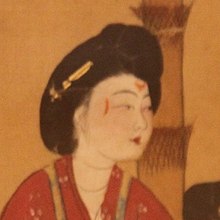
|
|
| Taohuazhuang(Chinese:Đào hoa trang;lit.'plum blossom make up') | 
|
||||
| Tizhuang(Chinese:Đề trang;lit.'weeping makeup') | Leizhuang(Chinese:Lệ trang;lit.'tears makeup')[69] | A short-lived fashion trend, when powder and rouge were not popular on the face; and the only makeup that was worn is black lipstick.[30]: 37 | Mid-Tang - Mid-Tang | ||
| E huang(Chinese:Ngạch hoàng;lit.'Forehead yellow') or | Yahuang(Chinese:Nha hoàng)[69] | A forehead makeup where women painted their forehead yellow, which is believed to be in imitation of Northwestern ethnic minorities.[30]: 35 | Tang dynasty | ||
| Yuanyang(Chinese:Uyên ương;lit.'mandarin duck') | It is an eyebrow makeup.[30]: 35 [69] | Tang dynasty | |||
| Xiaoshan(Chinese:Tiểu sơn;lit.'small peak') | It is an eyebrow makeup.[30]: 35 [69] | Tang dynasty | |||
| Chuizhu(Chinese:Thùy châu;lit.'drooping pearl') | It is an eyebrow makeup.[30]: 35 [69] | Tang dynasty | |||
| Hanyan(Chinese:Hàm yên) | Known as "dark fog" in English.[30]: 35 | It is an eyebrow makeup.[30]: 35 [69] | Tang dynasty | ||
Modernhanfumakeup[edit]
Red makeup remain popular in Modernhanfumakeup of the 21st century with the use of red and/or pinkeyeshadow.[70]
See also[edit]
Gallery[edit]
-
Hanfu enthusiasts inshenyiholding oblong-shaped tuanshan
References[edit]
- ^abcMarks, Ben."Unraveling the Ancient Riddles of Chinese Jewelry".Collectors Weekly.Retrieved2022-08-30.
- ^abcdeYang, Xiaojing; Wang, Kunqian (2015). "Innovative design and application of woody materials in silver jewellery".Advances in future manufacturing engineering: proceedings of the 2014 IMSS International Conference on Future Manufacturing Engineering (ICFME 2014), Hong Kong, 10-11 December, 2014.G. Yang. Leiden, The Netherlands: CRC Press.ISBN978-1-315-68462-8.OCLC908931928.
- ^abcdef"Chinese Pendant Accessories | ChinaFetching".ChinaFetching.com.Retrieved2022-03-12.
- ^abYu, Ming (2011).Chinese jade(Updated ed.). Cambridge, UK: Cambridge University Press.ISBN978-0-521-18684-1.OCLC759918479.
- ^Metropolitan Museum of Art (1987).Ancient Chinese art: the Ernest Erickson Collection in the Metropolitan Museum of Art.Maxwell K. Hearn. New York: The Museum.ISBN0-87099-483-2.OCLC14242247.
- ^abThe first emperor: China's Terracotta Army.Jane Portal, Hiromi Kinoshita. Cambridge, Mass.: Harvard University Press. 2007.ISBN978-0-674-02697-1.OCLC123119878.
{{cite book}}:CS1 maint: others (link) - ^abcSullivan, Lawrence R. (2021).Historical dictionary of Chinese culture.Nancy Liu-Sullivan. Lanham.ISBN978-1-5381-4603-3.OCLC1225908476.
{{cite book}}:CS1 maint: location missing publisher (link) - ^abcd"A woman must have three jade bracelets".iNews.2021.
- ^"What does it mean to give a jade bracelet?".iNews.2021.
- ^Robertson, Iain (2016).Understanding art markets: inside the world of art and business.Iain Robertson ([2 Edition] ed.). Abingdon, Oxon.ISBN978-1-135-09193-4.OCLC934904120.
{{cite book}}:CS1 maint: location missing publisher (link) - ^abcdefghi"Hán phục na ta sự nhi —— hán phục phối sức tri đa thiếu _ đằng tấn tân văn".new.qq.com.Retrieved2022-09-01.
- ^abcdefghijk"Chinese Jewelry — History, Tradition, and Culture | ChinaFetching".ChinaFetching.com.Retrieved2022-08-30.
- ^abcde"Earrings Reveal Ancient Tradition".www.china.org.cn.Retrieved2022-08-30.
- ^ab5000 years of Chinese costumes.Xun Zhou, Chunming Gao, chu tấn, Shanghai Shi xi qu xue xiao. Zhongguo fu zhuang shi yan jiu zu. San Francisco, CA: China Books & Periodicals. 1987. pp. 32, 34.ISBN0-8351-1822-3.OCLC19814728.
{{cite book}}:CS1 maint: others (link) - ^The Museum of Far Eastern Antiquities.Vol. Bulletin No. 70. Stockholm: Östasiatiska museet. 1998.
- ^abRawski, Evelyn Sakakida (1998).The last emperors: a social history of Qing imperial institutions.Berkeley: University of California Press. p. 41.ISBN0-520-21289-4.OCLC37801358.
- ^Walthall, Anne (2008).Servants of the dynasty: palace women in world history.Berkeley: University of California Press. pp. 143–144.ISBN978-0-520-94151-9.OCLC560506301.
- ^"Ancient Chinese Lock Charms".primaltrek.com.Retrieved2022-08-30.
- ^Grant, Lee; Wiencke, Brett; Carroll, Alice (2015).The five happinesses =: Wu xing fu.Sydney?: Jungle Books.ISBN978-0-9942003-0-3.
- ^abYu, Ming (2011).Chinese jade.Cambridge, UK: Cambridge University Press. pp. 58–61, 67–69.ISBN978-0-521-18684-1.OCLC759918479.
- ^Chinese sculpture.Angela Falco Howard. New Haven: Yale University Press. 2006. p. 49.ISBN0-300-10065-5.OCLC51631315.
{{cite book}}:CS1 maint: others (link) - ^Guozhen, Wang (2019).Collection of Ancient Chinese Cultural Relics. Volume 1.Adelaide. pp. 49–54, 154–156, 158.ISBN978-1-925371-29-1.OCLC1175916450.
{{cite book}}:CS1 maint: location missing publisher (link) - ^Clark, Carol (1998).Tropical gemstones.Singapore: Periplus Editions. p. 58.ISBN978-1-4629-1664-1.OCLC904404624.
- ^"Liji: Yu Zao - Chinese Text Project".ctext.org.Retrieved2022-03-12.
- ^abcGarrett, Valery M. (2007).Chinese dress: from the Qing Dynasty to the Present.Tokyo: Tuttle Pub.ISBN978-0-8048-3663-0.OCLC154701513.
- ^"Why did Cixi's beloved Qing dynasty 18 jadeites sell at a high price of 1.725 million?".iNews.2022.
- ^ab"These beads can't be bought with money".iNews.2022.
- ^abcdefSheng, Angela (1995)."The Disappearance of Silk Weaves with Weft Effects in Early China".Chinese Science(12): 41–76.ISSN0361-9001.JSTOR43290485.
- ^abcdefgLaursen, Sarah (2019). "10 Dressing the Dead in Jin China".The art and archaeology of bodily adornment: studies from Central and East Asian mortuary contexts.Sheri Lullo, Leslie V. Wallace. Abingdon, Oxon: Routledge. pp. 176–195.ISBN978-1-351-26832-5.OCLC1090702934.
- ^abcdefghijklmnopHua, Mei (2004).Chinese Clothing(1 ed.). Beijing: China Intercontinental Press.ISBN7-5085-0540-9.OCLC60568032.
- ^abBaohai, Dang; đảng bảo hải; Dang, Baohai (2003)."The Plait-line Robe. A Costume of Ancient Mongolia".Central Asiatic Journal.47(2): 198–216.ISSN0008-9192.JSTOR41917645.
- ^Chen, Buyun (2019).Empire of style: silk and fashion in Tang China.Seattle. p. 84.ISBN978-0-295-74531-2.OCLC1101879641.
{{cite book}}:CS1 maint: location missing publisher (link) - ^"Women Fashion of Tang Dynasty and Foreign Cultural Communication--《Journal of Zhejiang Wanli University》2008 niên 01 kỳ".en.cnki.com.cn.Retrieved2021-04-09.
- ^abcLewandowski, Elizabeth J. (2011).The complete costume dictionary.Dan Lewandowski. Lanham, Maryland. p. 319.ISBN978-0-8108-4004-1.OCLC694238143.
{{cite book}}:CS1 maint: location missing publisher (link) - ^abcdZhongguo xie zhen hua.Shanming Guan, quan thiện minh (Di 1 ban ed.). Xianggang: Mu wen tang mei shu chu ban she you xian gong si. 2003. pp. 38, 46.ISBN988-97206-2-0.OCLC56424659.
{{cite book}}:CS1 maint: others (link) - ^Garrett, Valery M. (2007).Chinese dress: from the Qing Dynasty to the Present.Tokyo: Tuttle Pub.ISBN978-0-8048-3663-0.OCLC154701513.
- ^Yang, Yuxin (9 April 2018)."Unveiling and Activating the" Uncertain Heritage "Of Chinese Knotting".ACCS 2018 Conference Proceedings.
- ^abGarrett, Valery (2012).Chinese Dress: From the Qing Dynasty to the Present.New York: Tuttle Pub. p. 184.ISBN978-1-4629-0694-9.OCLC794664023.
- ^abShea, Eiren L. (2020-02-05).Mongol Court Dress, Identity Formation, and Global Exchange.Routledge.doi:10.4324/9780429340659.ISBN978-0-429-34065-9.S2CID213078710.
- ^Yang, Shaorong (2004).Traditional Chinese clothing: costumes, adornments & culture(1st ed.). San Francisco: Long River Press.ISBN1-59265-019-8.OCLC52775158.
- ^abcdefgBurkus, Anne Gail (2010).Through a forest of chancellors: fugitive histories in Liu Yuan's Lingyan ge, an illustrated book from seventeenth-century Suzhou.Yuan, active Liu. Cambridge, Mass. p. 92.ISBN978-1-68417-050-0.OCLC956711877.
{{cite book}}:CS1 maint: location missing publisher (link) - ^Ho, Peng Yoke (2007).Explorations in Daoism: medicine and alchemy in literature.John P. C. Moffett, Cho Sungwu. London: Routledge.ISBN978-0-203-96680-8.OCLC127264736.
- ^Zhu, Ruixi; chu thụy hi (2016).A social history of middle-period China: the Song, Liao, Western Xia and Jin dynasties.Bangwei Zhang, Fusheng Liu, Chongbang Cai, Zengyu Wang, Peter Ditmanson, Bang Qian Zhu (Updated ed.). Cambridge, United Kingdom: Cambridge University Press. p. 23.ISBN978-1-107-16786-5.OCLC953576345.
- ^abcd"Chinese Fans | Chinese Art Gallery | China Online Museum".www.chinaonlinemuseum.com.Retrieved2021-03-28.
- ^Qian, Gonglin (2004).Chinese fans: artistry and aesthetics(1st ed.). San Francisco: Long River Press.ISBN1-59265-020-1.OCLC52979000.
- ^abcQian, Gonglin (2004).Chinese fans: artistry and aesthetics(1st ed.). San Francisco: Long River Press. pp. 3–4.ISBN1-59265-020-1.OCLC52979000.
- ^ab"A Brief Introduction to Hanfu's Fans Culture - 2021".www.newhanfu.com.2019-06-04.Retrieved2021-03-28.
- ^abcQian, Gonglin (2004).Chinese fans: artistry and aesthetics(1st ed.). San Francisco: Long River Press. pp. 8, 12–16.ISBN1-59265-020-1.OCLC52979000.
- ^"A Brief History of Ancient Chinese Umbrellas - 2022".www.newhanfu.com.2021-08-08.Retrieved2022-09-02.
- ^abcdefLu, Zhouxiang (2018).Politics and identity in Chinese martial arts.New York.ISBN978-1-315-10843-8.OCLC1040592866.
{{cite book}}:CS1 maint: location missing publisher (link) - ^abcThe Routledge handbook of sport in Asia.Hong Fan, Zhouxiang Lu, Routledge (1st ed.). Milton Park, Abingdon, Oxon. 2020.ISBN978-0-429-06120-2.OCLC1155521633.
{{cite book}}:CS1 maint: location missing publisher (link) CS1 maint: others (link) - ^abChang, Shih-Ming Li (2016).Chinese dance: in the vast land and beyond.Lynn E. Frederiksen. Middletown, Connecticut.ISBN978-0-8195-7632-3.OCLC945434393.
{{cite book}}:CS1 maint: location missing publisher (link) - ^abcdHargett, James M. (2018).Jade mountains & cinnabar pools: the history of travel literature in imperial China.Seattle.ISBN978-0-295-74448-3.OCLC1052903338.
{{cite book}}:CS1 maint: location missing publisher (link) - ^"Chinese character guī khuê jade tablet".www.chinasage.info.Retrieved2022-08-30.
- ^"GLOSSARY: Jade".gotheborg.com.Retrieved2022-08-30.
- ^Dong, Jin; đổng tiến. (2011).Q ban da Ming yi guan tu zhi(Di 1 ban ed.). Beijing Shi: Beijing you dian da xue chu ban she.ISBN978-7-5635-2501-0.OCLC828035990.
- ^abHan, B.; Chong, J.; Sun, Z.; Jiang, X.; Xiao, Q.; Zech, J.; Roberts, P.; Rao, H.; Yang, Y. (2021)."The rise of the cosmetic industry in ancient China: Insights from a 2700‐year‐old face cream".Archaeometry.63(5): 1042–1058.doi:10.1111/arcm.12659.hdl:21.11116/0000-0007-F2BF-1.ISSN0003-813X.S2CID234062944.
- ^abcdefghijChō, Kyō (2012).The search for the beautiful woman: a cultural history of Japanese and Chinese beauty.Kyoko Iriye Selden. Lanham: Rowman & Littlefield Publishers, Inc.ISBN978-1-4422-1895-6.OCLC824351053.
- ^Benn, Charles D. (2002).Daily life in traditional China: the Tang dynasty.Westport, Conn.: Greenwood Press.ISBN0-313-00687-3.OCLC51743549.
- ^abcdHaney, Beth (2020).Aesthetic procedures: nurse practitioner's guide to cosmetic dermatology.Cham.ISBN978-3-030-19948-7.OCLC1121273169.
{{cite book}}:CS1 maint: location missing publisher (link) - ^Yu, Z. R.; Wang, X. D.; Su, B. M.; Zhang, Y. (2017)."First Evidence Of The Use Of Freshwater Pearls As A Cosmetic In Ancient China: Analysis Of White Makeup Powder From A Northern Song Dynasty Lv Tomb (Lantian, Shaanxi Province, China): The use of freshwater pearls as a cosmetic in ancient China".Archaeometry.59(4): 762–774.doi:10.1111/arcm.12268.
- ^abcHill, Degen (2018)."China's fair skinned obsession".www.china.org.cn.
- ^Color matters: skin tone bias and the myth of a postracial America.Kimberly Jade Norwood. New York. 2014.ISBN978-1-317-81955-4.OCLC869281941.
{{cite book}}:CS1 maint: location missing publisher (link) CS1 maint: others (link) - ^Lan, Shanshan (2012).Diaspora and class consciousness: Chinese immigrant workers in multiracial Chicago.New York: Routledge.ISBN978-0-415-89036-6.OCLC698324613.
- ^Chō, Kyō (2012).The search for the beautiful woman: a cultural history of Japanese and Chinese beauty.Kyoko Iriye Selden. Rowman & Littlefield Publishers, Inc.ISBN9781442218956.OCLC824351053.
- ^Red and yellow, black and brown: decentering whiteness in mixed race studies.Joanne L. Rondilla, Rudy P., Jr. Guevarra, Paul R. Spickard. New Brunswick, New Jersey. 2017.ISBN978-0-8135-8733-2.OCLC990142162.
{{cite book}}:CS1 maint: location missing publisher (link) CS1 maint: others (link) - ^Blanchard, Lara C. W. (2018).Song dynasty figures of longing and desire: gender and interiority in Chinese painting and poetry.Leiden.ISBN978-90-04-36939-9.OCLC1039203421.
{{cite book}}:CS1 maint: location missing publisher (link) - ^Draelos, Zoe Diana (2011).Cosmetic Dermatology: Products and Procedures.Somerset: Wiley.ISBN978-1-4443-5951-0.OCLC929529116.
- ^abcdefghijHua, Mei; hoa mai (2004).Zhongguo fu shi(in Chinese) (Di 1 ban ed.). Beijing: Wu zhou chuan bo chu ban she.ISBN7-5085-0540-9.OCLC60568032.
- ^"3 Basic Elements of Classical Hanfu Makeup".www.newhanfu.com.2020-10-25.Retrieved2022-09-03.








